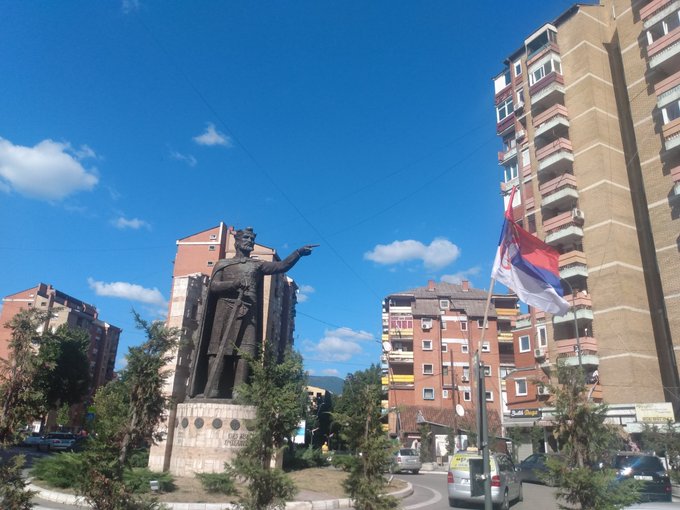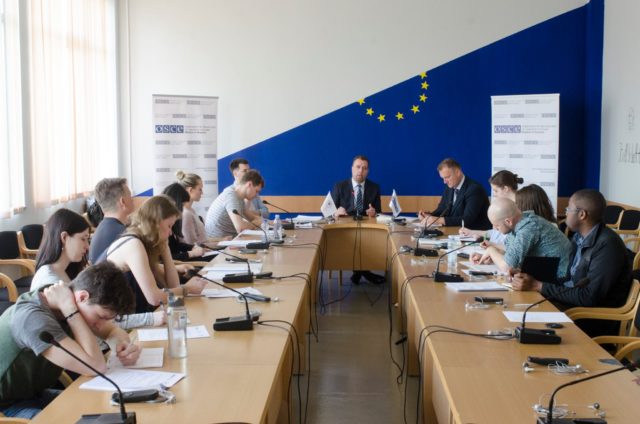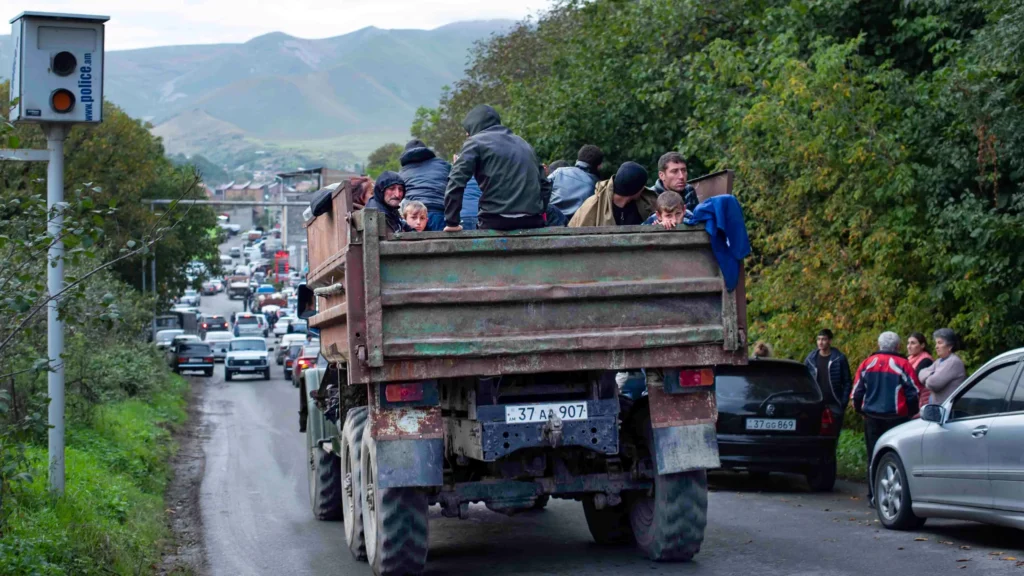What Next for Normalisation?
As the last of the Yugoslav Wars to come to an end, and the one in which the least conclusive peace was achieved, Kosovo continues to be a subject of intense academic scholarship. After the withdrawal of Serbian government forces from the region in 1999, the region was placed under UN administration, until a new Kosovar government declared independence unilaterally in 2008. Kosovo has been recognised by almost 100 UN members as a sovereign state – though not, of course, by Serbia. More recently, the focus has moved to the negotiations which have been taking place through EU mediation since 2011, which are aimed at ‘normalising’ relations between Kosovo and Serbia.
In late September 2023, a delegation of students and lecturers from the Johan Skytte Institute of Political Studies, University of Tartu, travelled to Kosovo for a field trip. The trip was organised as part of the module: ‘Practical Field Research in Conflict Areas,’ in which students are offered the chance to complement their studies of a particular case study with first-hand experience of the dynamics on the ground, as well as the opportunity to speak directly with parties involved. In travelling to Kosovo, we hoped to gain a deeper understanding of the ‘normalisation process’ on the ground and learn about the prospects for a permanent settlement of Kosovo’s issues.
Less than 24 hours after our arrival to Pristina, the context of our visit changed considerably. News emerged of a violent incident which took place in the village of Banjska, just north of Mitrovica, in which around thirty heavily-armed Kosovar Serb gunmen barricaded themselves in an Orthodox Christian monastery. The subsequent police operation to clear the monastery resulted in a firefight which claiming the lives of three gunmen and one Kosovo Albanian policeman – making it the deadliest single day of violence in Kosovo in 15 years. Understandably, this incident overshadowed our engagements during the week, and it served as a reminder of the volatility which is inherent to all conflict areas, even those with long periods of apparent inactivity.
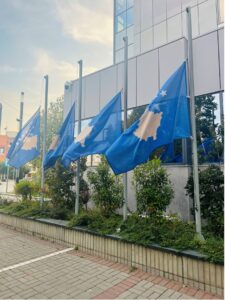
Image: Flags in Pristina flying at half-mast during the official day of mourning for the policeman killed in Banjska, 25th September 2023 (Source: Iti Teder)
Both Kosovar Prime Minister Albin Kurti and Serbian President Aleksandar Vučić condemned the violence of the other side and declared national days of mourning. With flags around Pristina flying at half mast, our first day of engagements at the Rochester Institute of Technology, Kosovo Campus began with a warm welcome from its president, Dr. Kamal Shahrabi. Dr. Robert Muharremi led an insightful introductory session to bring the group fully up-to-date with the latest developments on the political front, including the incident in Banjska. This was followed by contributions from RITK faculty such as Dr. Leandrit Mehmeti and Mentor Nimani. With their academic and professional insights, each gave their views on Kosovo’s political progress in recent years and their impressions of how recent events might shape the coming months.
Overall, it is probably fair to say that the conclusions of these sessions were not overly optimistic: even before the violence in Banjska, rhetoric coming from the governments in Pristina and Belgrade had been growing ever more divergent, with the prospects of a breakthrough in the ‘normalisation talks’ appearing less and less likely. On the ground, relations between the Kosovo government and the Serbs in the north of the country had been worsening for some time, though the events in Banjska were said to represent a significant further deterioration in the situation.
These sentiments were echoed by those we met who had first-hand experience of Kosovo’s international negotiations, such as Ms. Vlora Çitaku and Dr. Bernard Nikaj, Kosovo’s former Ambassadors to the United States and European Union, respectively. Both contributors emphasised the gains Kosovo has been successful in making on the international stage since its declaration of independence, and agreed that progress has also been achieved with Serbia in certain areas. However, it was clear from both that the task of international representation for a partially-recognised state is a very difficult one, with the opposition of Serbia and its allies presenting significant challenges to Kosovo’s efforts to engage with the international community.
The lengths which can be taken in this regard can sometimes be very striking: Ms. Çitaku recalled a story in which her presentation to a sitting of the UN Security Council was interrupted by a Serbian representative brandishing a copy of her birth certificate in an effort to ‘prove’ her Serbian nationality. Listening to anecdotes like that one, it was certainly difficult to imagine how talks between Serbia and Kosovo could achieve much progress if such tactics were part of the playbook.
In some senses, the uncertainty of Kosovo’s political wranglings for recognition and agreements seems at-odds with the situation on the ground: walking around central Pristina, with its numerous bars, restaurants, mosques and murals dedicated to pacifist leader Ibrahim Rugova and popstar Dua Lipa, there’s little to suggest that you’re in a European capital unlike any other. The city has a welcoming vibrancy to it, and it’s clearly growing rapidly, with new apartment blocks and retail units seemingly going up on every corner. Kosovar and Albanian flags are plentiful, of course, as are references to the paramilitary group (UÇK, or Kosovo Liberation Army) which fought the forces of Slobodan Miloševićuntil NATO intervened in March 1999.
Physical remnants of the war, however, are very difficult to find. Perhaps the biggest war-related imprint on modern Pristina is the statue of a waving Bill Clinton which watches over the lines of traffic crawling down Bill Clinton Boulevard. As the most prominent actors in the NATO intervention, the U.S. is still very much in vogue, while Turkey’s involvement in the region seems to be growing too; many of Pristina’s beautiful historic mosques have been renovated in recent times with the help of Turkish funding.

Image: The statue of Bill Clinton which presides over Bill Clinton Boulevard in Prishtina, 23rd September 2023 (Source: Cian Deasy)
In the aftermath of the 1999 war, Kosovo was practically inundated with international organisations coming to assist in its post-conflict recovery, and the international presence in the country remains considerable. The United Nations’ Mission in Kosovo (UNMIK) was originally established to act as the de facto administration of the province, and had more than 11,000 members of staff at its height: now, with the task of governing now in the hands of Kosovo’s own government, UNMIK’s role is more limited, and the mission is focused on areas such as protecting human rights and assisting in statistics-gathering. The OSCE, meanwhile, played a significant role in building Kosovo’s new institutions in the post-1999 period, and it remains the international organisation with the greatest reach, with missions in all 38 of Kosovo’s municipalities.
We were fortunate to meet delegations from both bodies, including the head of the OSCE’s Kosovo Mission, Ambassador Michael Davenport, and we were keen to find out how both organisations see their roles in Kosovo today, as well as their views on recent political developments. The delegations from both organisations who spoke with us were keen to stress their involvements in cross-community programs, particularly those focused on bringing young people from Serbian and Albanian communities together. The challenges facing these efforts remain considerable, especially since the numbers of Kosovars who are proficient speakers of both Albanian and Serbian has been in long-term decline: when youth events take place, often they are run through English. Nevertheless, there is clearly a feeling that improving contacts and relations among Kosovo’s youth is key to securing a brighter future for all of the country’s communities.
A particular highlight of the trip was our meeting with Ms. Edita Tahiri. Formerly a political colleague of Ibrahim Rugova in his LDK party, Ms. Tahiri served as the Deputy Prime Minister and Minister for Dialogue during a six-year stint in the Kosovo cabinet, and she also led Kosovo’s delegation in the EU-mediated ‘normalisation’ negotiations with Serbia. As part of our preparations for the study trip, the class had watched the 2013 television documentary, “The Agreement,” which had featured the negotiations in the lead-up to arranging a preliminary agreement, and it was wonderfully beneficial to be able to hear from and present questions to one of the main protagonists of the programme. Ms. Tahiri ended her involvement in the Kosovo cabinet in 2017, having served under Prime Ministers Hashim Thaci and Isa Mustafa. Now the government is led by Albin Kurti of the Vetëvendosje party, whose stance towards Serbia and the Kosovo Serbs has often been less compromising than his predecessors.
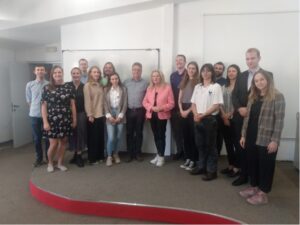
Image: Meeting Ms. Edita Tahiri at RIT Kosovo, 26th September 2023 (Source: Eiki Berg)
Despite the difficult timing of our visit, we were fortunate to meet the current Deputy Minister of Foreign Affairs, Ms. Liza Gashi. As one would expect, the nature of the discussion there was quite different to what we had experienced with the academics and former office-holders we had met previously, and Ms. Gashi echoed the sentiment that the violence in Banjska has fundamentally altered the state of play where Kosovo-Serbia relations are concerned. Days before our meeting, Prime Minister Kurti had claimed that Kosovo’s trust in the EU-mediated negotiations had been broken, and Ms. Gashi reiterated his belief that continuing ‘normalisation talks’ in the current context is unfeasible.
With its overwhelming Kosovar Albanian majority, the city of Pristina offers relatively little insight into Kosovo’s ethnic and linguistic diversity. For that, we decided to visit majority-Serb areas with highly contrasting impressions of the state of community relations. In Gračanica, located just outside Pristina, many of the shop signs are written in the Cyrillic script of the Serbian alphabet, while every streetlight is decorated with the red, blue and white of the Serbian flag. Serbia runs its own schools and health centres in parallel with those of Kosovo, and almost all seats on the municipal assembly are held by candidates of the Serbian List party, which is closely aligned with the Progressive Party of Aleksandar Vučić.
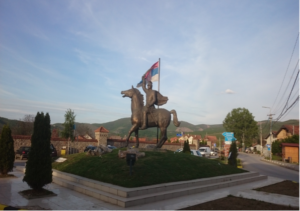
Image: Statue of Prince Lazar on horseback in Gračanica, 26th September 2023 (Source: Eiki Berg)
Vučić himself smiles from a billboard outside the headquarters of the local party branch, overlooking all those who sit waiting in the little town square or pass in and out of the municipality offices. Arriving in Gračanica, you might be forgiven for thinking you were in a little town a few kilometres outside Novi Sad, Kragujevac or Belgrade. Yet there is a Kosovo state presence there, one which, at least in certain aspects, functions. In fact, ethnic diversity has been part of life in Gračanica for centuries: just down the road from the municipal offices, the 700-year-old Serbian Orthodox monastery boasts brilliantly-preserved frescoes which have managed to survive countless periods of upheaval. Inter-ethnic violence has not been seen in the town for many years, and there have been limited recent attempts to encourage greater cross-community integration among the roughly 10,000 inhabitants of the municipality. One could question the success of such attempts when one hears that there have been no inter-ethnic marriages in Gračanica for at least 20 years, but still, it appears that the different communities have at least achieved stability in living alongside one another, if not quite together.
In Northern Kosovo, however, the situation is very different. The recent violence there can be seen as part of wider trend of deteriorating relations which began almost two years ago and which has seen the almost complete de facto separation of four Serb-majority municipalities from all Kosovo state structures. Progress which had been made in unifying rivalling Albanian and Serbian local governance and policing structures has unravelled entirely, and tensions are now at their highest point in many years. Given the events in Banjska, our scheduled trip to Mitrovica, on the ‘frontier’ between Albanian- and Serb-dominated areas, couldn’t take place as planned: the meetings which had been arranged with Serbian community representatives were cancelled for security reasons. We were fortunate to meet with staff members of the OSCE mission in South Mitrovica, the area of the city south of the Ibar river where most of its Albanian residents live, who described the mood among the local people in the days since the outbreak of violence.
There had not been any incidents in Mitrovica itself, and on the day of our visit, all was calm. That, coupled with the local knowledge and experience of our two lecturers, both of whom had been to the North previously and could gauge the situation, meant we were in a position to make a trip across the Ibar river to Serb-dominated North Mitrovica. As was the case with Gračanica, moving to the north part of Mitrovica felt like entering a new world: Serbian flags, symbols and murals adorn most available walls and buildings, while the prices in the shops and restaurants on the pedestrian street leading up from the river are given in Serbian dinars, not the euros used in the rest of Kosovo.
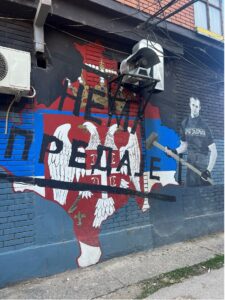
Image: Pro-Serbia mural in North Mitrovica, 28th September 2023 (Source: Iti Teder)
It was obvious that considerable investment has been put into the pedestrianised centre of North Mitrovica, and on the sunny September day when we visited, the atmosphere on both sides of the Ibar was quite pleasant. It was hard to believe that four men had been killed in a firefight a few kilometres to the north, only days before. Shortly after our visit, NATO announced that it would be strengthening its presence in the area through its KFOR operation, in response to a build-up of troops on the Serbian side of the border with northern Kosovo. Though the image we saw was a peaceful one, it’s clear that the estrangement between Mitrovica’s two communities seems no closer to being overcome.
Overall, our visit allowed us to experience Kosovo at an uncertain moment in its modern history. With an ever-growing estrangement between the rhetoric from Belgrade and Prishtina, what little momentum may have been behind negotiations with Serbia to reach a concrete normalisation agreement seems to have been lost. As was noted several times during our visit, events in Banjska have fundamentally altered the state of play, and we all hope that it will not end up heralding a return to greater violence. In the meantime, the young country is seeking to forge its own path and look to the future. However, the overwhelming impression of this observer is that such a future depends on building trust between all of Kosovo’s diverse communities. Without that, both for Kosovo’s internal harmony and its relations with its bigger neighbour, it is difficult to see how real and lasting progress can be made.
Author: Cian Deasy
A special thank goes to Drs. Eiki Berg and Shpend Kursani for their efforts in making this study trip a reality, and to all the students who helped to make it an absolute highlight of my studies at the Johan Skytte Institute of Political Studies.


